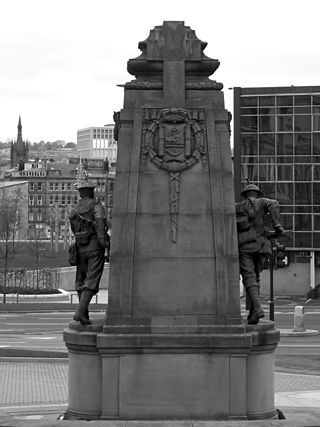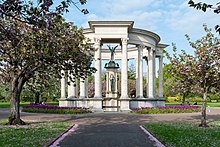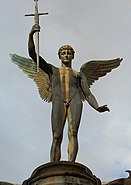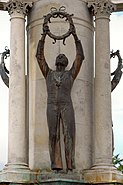
Ian Rank-Broadley FRBS is a British sculptor who has produced many acclaimed works, among which are several designs for British coinage and the memorial statue of Princess Diana at Kensington Palace, which was unveiled on her 60th birthday in 2021.

National Museum Cardiff, formerly known as the National Museum of Wales, is a museum and art gallery in Cardiff, Wales. The museum is part of the wider network of Amgueddfa Cymru – Museum Wales. Entry is kept free by a grant from the Welsh Government.

City Hall is a municipal building in Cardiff, Wales, UK. It serves as Cardiff's centre of local government. It was built as part of the Cathays Park civic centre development and opened in October 1906. Built of Portland stone, it is an important early example of the Edwardian Baroque style. It is a Grade I listed building.

Sir Edgar Bertram Mackennal, usually known as Bertram Mackennal, was an Australian sculptor and medallist, most famous for designing the coinage and stamps bearing the likeness of George V. He signed his work "BM".

Sir William Goscombe John was a prolific Welsh sculptor known for his many public memorials. As a sculptor, John developed a distinctive style of his own while respecting classical traditions and forms of sculpture. He gained national attention with statues of eminent Victorians in London and Cardiff and subsequently, after both the Second Boer War and World War I, created a large number of war memorials. These included the two large group works, The Response 1914 in Newcastle upon Tyne and the Port Sunlight War Memorial which are considered the finest sculptural ensembles on any British monument. Although as a young man he adopted the first name Goscombe, taken from the name of a village in Gloucestershire near his mother's home, he was actively engaged with his native Wales and Welsh culture throughout his career.

Sir John Ninian Comper was a Scottish architect, one of the last of the great Gothic Revival architects.

St Cyprian's Church is a parish church of the Church of England in the Marylebone district of London. The church was consecrated in 1903, but the parish was founded in 1866. It is dedicated to Cyprian, a third-century martyr and bishop of Carthage and is near the Clarence Gate Gardens entrance to Regent's Park, off Baker Street. The present church was designed by Ninian Comper and is a Grade II* listed building.

Robert Thomas was a Welsh sculptor born in Cwmparc in the Rhondda Valley. He is best known for his work in bronze sculptures, many of which are on public display. He was one of the members of the 'Rhondda Group'.

Henry Alfred Pegram was a British sculptor and exponent of the New Sculpture movement.
Gilbert William Bayes was an English sculptor. His art works varied in scale from medals to large architectural clocks, monuments and equestrian statues and he was also a designer of some note, creating chess pieces, mirrors and cabinets.
Henry Charles Fehr FRBS was a British monumental and architectural sculptor active in the late nineteenth and early twentieth centuries. He produced several notable public sculptures, war memorials and works for civic buildings. These included architectural sculptures for Middlesex Guildhall, for Wakefield County Hall and for Cardiff City Hall. Throughout the 1920s, Fehr created a number of war memorials, often featuring detailed bronze statuary, for British towns and cities. Notable examples of Fehr's war memorials include those at Leeds, Colchester, Keighley and at Burton upon Trent.

The Old Steine Gardens in Brighton, Brighton and Hove, East Sussex, England, adjacent to the Old Steine thoroughfare, are the site of several monuments of national historic significance.

The Parliamentary War Memorial, also known as the Recording Angel Memorial, is a stone sculpture in Westminster Hall, unveiled in 1922, which commemorates the members of both Houses of Parliament of the United Kingdom who died in the First World War. It names 22 members of the House of Commons, 20 members of the House of Lords, and 9 senior members of staff, together with another 94 sons of members and officers of the House of Commons, who lost their lives in the war. Above the memorial is a large stained glass window which commemorates members and staff of both Houses who died in the Second World War.

The statue of the Earl Kitchener is an outdoor bronze statue by John Tweed depicting Herbert Kitchener, 1st Earl Kitchener, installed in 1926 and located on the south side of Horse Guards Parade in London, United Kingdom. The sculpture stands on a Portland stone plinth. It became a Grade II listed building in 1970.

The London Troops War Memorial, located in front of the Royal Exchange in the City of London, commemorates the men of London who fought in World War I and World War II.

The South African War Memorial, also known as the Boer War Memorial, is a war memorial in Cardiff, Wales. It was erected in 1908 and unveiled by General Sir John French on 20 November 1909 to honour the victims of the Second Boer War. It is a Grade II* listed structure.

St Saviour's War Memorial is a war memorial on Borough High Street, in the former parish of Southwark St Saviour, to south of the River Thames in London. It became a Grade II listed building in 1998 and was upgraded to Grade II* in 2018.

The equestrian statue of Ferdinand Foch stands in Lower Grosvenor Gardens, London. The sculptor was Georges Malissard and the statue is a replica of another raised in Cassel, France. Foch, appointed Supreme Commander of the Allied Forces on the Western Front in the Spring of 1918, was widely seen as the architect of Germany's ultimate defeat and surrender in November 1918. Among many other honours, he was made an honorary Field marshal in the British Army, the only French military commander to receive such a distinction. Following Foch's death in March 1929, a campaign was launched to erect a statue in London in his memory. The Foch Memorial Committee chose Malissard as the sculptor, who produced a replica of his 1928 statue of Foch at Cassel. The statue was unveiled by the Prince of Wales on 5 June 1930. Designated a Grade II listed structure in 1958, the statue's status was raised to Grade II* in 2016.

Bradford War Memorial commemorates the 37,000 men the English city of Bradford who served in the British Armed Forces in the First World War. Many of the 5,000 dead had served in the two Bradford Pals battalions and were killed on 1 July 1916, the first day of the First Battle of the Somme. The stone pylon with bronze statues was unveiled on 1 July 1922, in Victoria Square, beside Prince's Way, to the northeast of the Grade II listed Queen Victoria Memorial. A bronze plaque was added after the Second World War, and the memorial also commemorates later conflicts. It stands between the National Media Museum and Alhambra Theatre, Bradford, and was Grade II listed in 2016.

St Peter-in-Ely or St Peter's Church, Ely, is a Church of England proprietary chapel in Ely, Cambridgeshire, England, located on Broad Street. The chapel is in the Diocese of Ely and follows the Anglo-Catholic or high-church tradition of the Church of England.






















